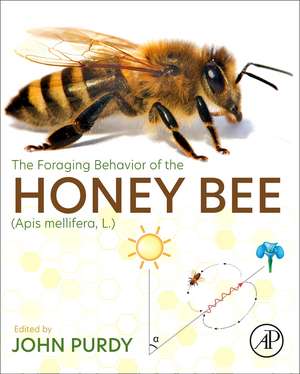The Foraging Behavior of the Honey Bee (Apis mellifera, L.)
Editat de John Purdyen Limba Engleză Paperback – 24 oct 2023
This book explores the fascinating world of honey bees in their struggle to obtain food and resources in the ecosystem and environment around the hive. Written by a team of international experts on honey bee behavior and ecology, this book covers current and historical knowledge, research methods and modeling used in the field of study and includes estimates of key parameters of energy utilization, quantities of materials collected, and identifies inconsistencies or gaps in current knowledge in the field.
- Establishes a basis of current knowledge on honeybees to build and advance understanding of their foraging behavior
- Addresses stressors such as habitat loss, climate change, pesticides, pests and diseases
- Presents concise concepts that facilitate direct traceability to the original underlying research
Preț: 669.12 lei
Preț vechi: 876.84 lei
-24% Nou
Puncte Express: 1004
Preț estimativ în valută:
128.05€ • 139.05$ • 107.56£
128.05€ • 139.05$ • 107.56£
Carte tipărită la comandă
Livrare economică 16-30 aprilie
Livrare express 18-22 martie pentru 78.89 lei
Preluare comenzi: 021 569.72.76
Specificații
ISBN-13: 9780323917933
ISBN-10: 0323917933
Pagini: 232
Dimensiuni: 191 x 235 x 15 mm
Greutate: 0.41 kg
Editura: ELSEVIER SCIENCE
ISBN-10: 0323917933
Pagini: 232
Dimensiuni: 191 x 235 x 15 mm
Greutate: 0.41 kg
Editura: ELSEVIER SCIENCE
Public țintă
Conservation biologists, animal behaviorists, apiary practitioners; Ecologists, urban planners, environmental risk assessment administratorsCuprins
1. Introduction to honey bee foraging
2. Honey bee adaptations for foraging
3. Honey bee foraging behavior, navigation, communication, and search patterns of individual bees
4. Energetics of foraging
5. Pollination and foraging ecology of individual honey bees
6. Delivery of resources by returning foragers
7. Colony-level adaptations for foraging
8. Modeling of colony and bee behavior
9. Honey bees as livestock
10. Specialized foraging – robbing, swarming, absconding
11. Knowledge gaps and future directions
2. Honey bee adaptations for foraging
3. Honey bee foraging behavior, navigation, communication, and search patterns of individual bees
4. Energetics of foraging
5. Pollination and foraging ecology of individual honey bees
6. Delivery of resources by returning foragers
7. Colony-level adaptations for foraging
8. Modeling of colony and bee behavior
9. Honey bees as livestock
10. Specialized foraging – robbing, swarming, absconding
11. Knowledge gaps and future directions
Recenzii
"...an introduction to the foraging ecology of the world’s dominant pollinating insect, the western honey bee.... The introductory chapter is especially good [and] includes an especially complete illustration and table detailing important clades from the ancestral Hymenoptera, through the origin of true bees from ammoplanine (thrips hunting) wasps, and up to the groups within the family Apidae, tribe Apini, and species of the largely paleotropical honey bee genus Apis. Geological time estimates, and supporting references, are given for these evolutionary changes that are rarely present in other volumes on honey bees and their biology.... Another excellent discussion is Chapter 6 on pollination ecology...." --Stephen L. Buchmann, The Quarterly Review of Biology
